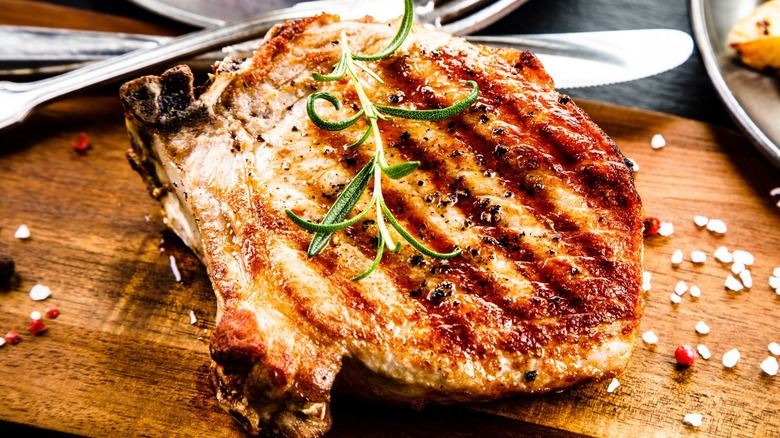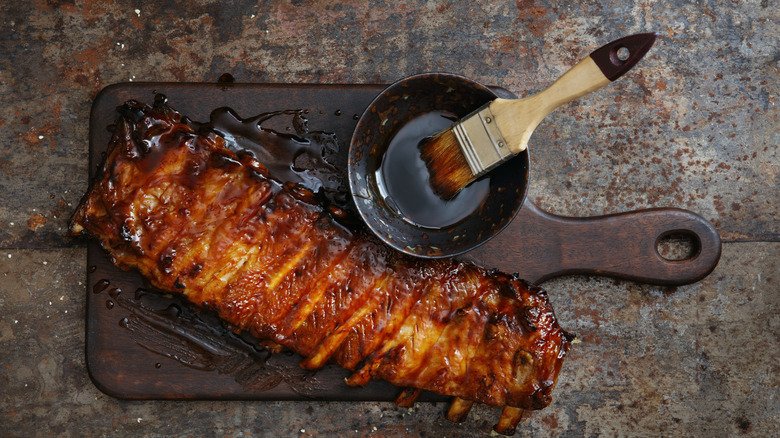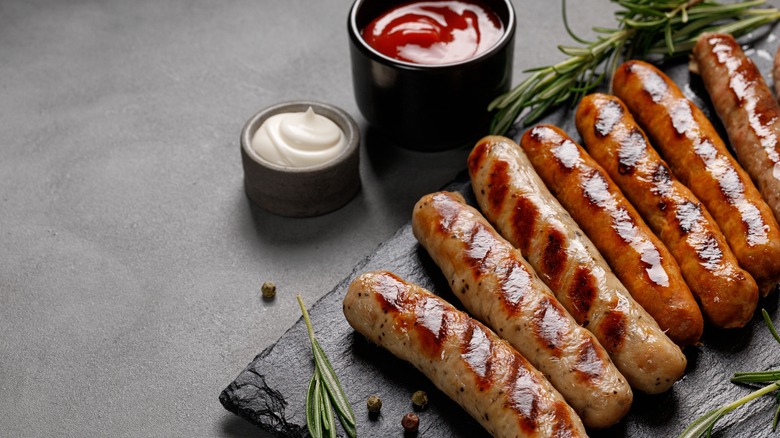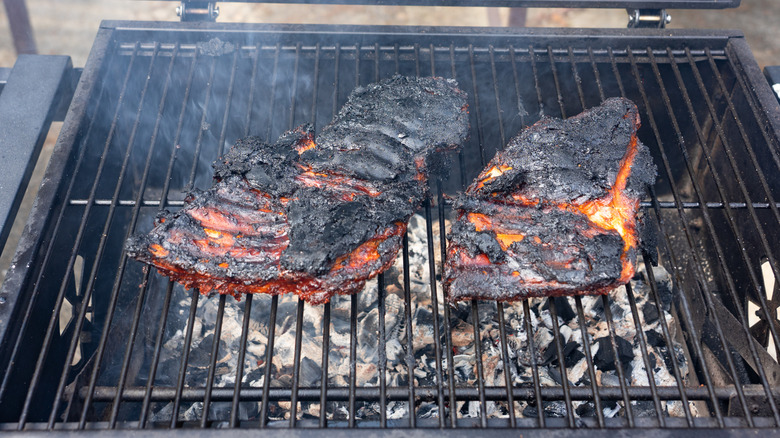Expert Explains The Best Ways To Prepare And Grill Pork This Summer
With barbecue season in full swing, you may be looking to go beyond the typical flame-kissed burger or seasoned grilled steak. Instead, why not branch out and try a different type of protein? Pork offers a wide range of cuts so that you can please the taste of any barbecue aficionado. However, if this is your first time grilling pork, you may want the help of a professional so that you can take your skills to a whole new level. In an exclusive interview with Mashed, Mel Coleman, Co-Founder of Coleman Natural Foods, gave us some tips about preparing and grilling pork this summer.
First off, you need to know your pork and which cuts are best for popping on your BBQ. "Pork chops are especially delicious on the grill," Coleman said. "Whether they are bone-in or boneless, look for chops cut at least 1 inch thick, so they don't cook too quickly and dry out." He also mentioned, "Pork tenderloin is another cut that's ideal on the grill since they are thicker in the middle, which helps them to stay nice and juicy while achieving a crisp crust." Although he also suggested pork hot dogs and kielbasa as juicy choices for the grill, Coleman said, "For a real showstopper, try grilling pork shoulder or pork butt. These big cuts have to be cooked slowly over low, indirect heat. It could take up to six hours, but the result is ultra-tender pork that makes a wonderful weekend meal."
The best prep technique for BBQ pork
Any avid barbecue boss may tell you that if you want the most from your meat, it needs to be prepared properly. To achieve this, there are a few avenues you can follow before the meat touches heat. "To keep things simple while still being delicious, salting is the best way to go," expert Mel Coleman told Mashed. "After salting, you can add more flavor by adding a dry rub of spices and flavorings like garlic, onion, fresh herbs — just make sure not to add more salt!" Alternatively, there are many benefits to utilizing an important brining method to introduce some savory taste. "A brine is a salty liquid that helps introduce moisture and salt into the meat," Coleman explained. "The amount of finished brine to make will vary depending on the size of your cut, as you just need enough to cover the meat completely."
Finally, there are plenty of marinade recipes that can take your BBQ pork to a whole new level. Whether you want to incorporate Asian-fusion ingredients or even some spicy curry flavor, allowing your meat to soak up a good sauce can make all the difference. "Marinades, especially low salt marinades, can actually stay on your pork for much longer than a brine," Coleman shared. "Because a brine's purpose is to add moisture and a marinade's purpose is to bring more flavor, you can utilize both a brine and a marinade together."
Perfecting flame-grilled pork sausages
To say that hot dogs and sausages are popular grill choices in the United States would be a massive understatement. According to the National Hot Dog and Sausage Council, Americans forked over $8.3 billion on these barbecued meats in 2022. But just because these pork items are widely accessible and easy to cook doesn't mean that you're doing it properly. "It's important to remember that hot dogs don't need to be grilled long and should be cooked at a lower temperature than you normally would think," Mel Coleman shared with us. "Hot dogs and sausages do best in medium-low heat, or between 250 and 325 degrees Fahrenheit."
If you want the best-tasting wieners this summer, you should invest in a meat thermometer to ensure the most satisfactory results. "Hot dogs are ready when they reach an internal temperature of at least 140 degrees Fahrenheit," Coleman explained. "For whole kielbasa, cut the sausage rope into bun-length pieces, and grill for 4-6 minutes on each side. When the kielbasa reaches an internal temp of 145 degrees Fahrenheit, they're hot enough to eat." Because of their cylindrical shape, you need to play that grill like a maestro if you want them evenly cooked. "Standard grilling procedure for smoked sausages is to keep them moving," Coleman advised. "You do this to prevent burning or bursting as well as to keep the meat as moist and tender as possible."
Avoid these mistakes when barbecuing pork
Once your pork is prepped and you're ready to toss those savory cuts onto the grill, it's helpful to know some of the common mistakes that people make so that your next barbecued meal doesn't wind up in a cooking catastrophe. "While you can choose any herbs and spices you like, don't skimp on the salt!" Mel Coleman emphasized in his interview with Mashed. "Pre-salting your pork will draw internal water to the surface. The liquid will then dissolve the salt and reabsorb back into the pork, allowing the salt to evenly distribute throughout the cut." He also made note that the size of your cut of meat will determine the timing of your seasoning. According to Coleman, "The larger the piece of meat, the earlier you should salt it."
Coleman also gave fair warning when it comes to brining your pork. "Be careful with how long you brine your meat — a smaller cut like a pork chop only needs about 30 minutes to brine," he suggested. "If you go too long, the meat can get too salty or become mushy. The bigger the cut, the more time you'll need to brine your meat." Finally, everyone loves to slather sauces on those pork pieces, but Coleman cautioned that this too should be timed just right. "If you plan to brush your pork with a high-sugar sauce, wait to apply until the last few minutes of grilling to avoid burning."



